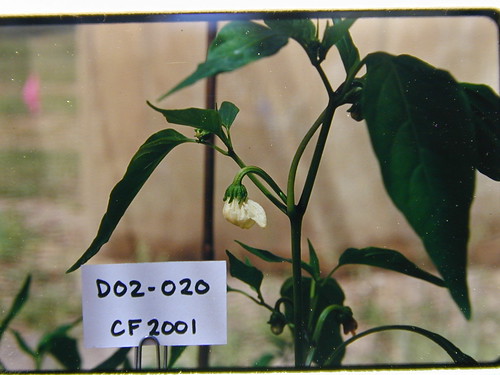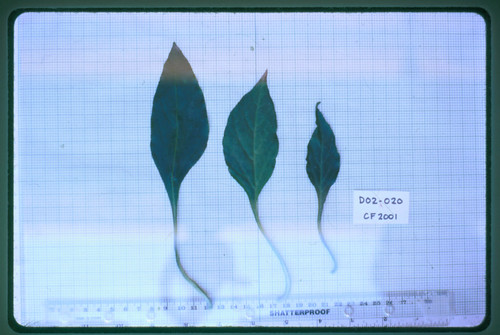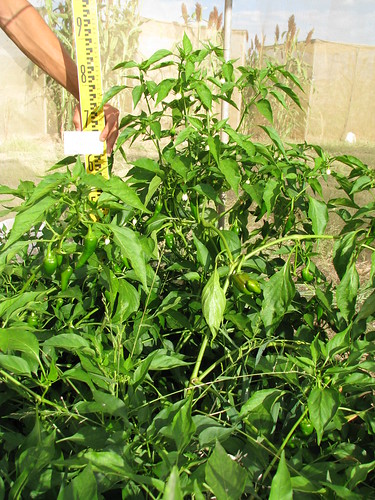ADAPTS
the Adaptive Drylands Agriculture Portal for The Southwest
D02-020
Collection | Availability | Map | Climate | Photographs | Observations | Cultivation & Seed Saving | Feedback
Basic Collection Information and Status
Chile (Capsicum annuum, Solanaceae)
Cultural Affiliation Jemez PuebloCollection Site New Mexico, United States (latitude: 36°; altitude: 6,000 ft / 1,800 m)
Collection Year 1990
Accession Status Active
Catalog Information and Instructions
JemezD019
From Jemez Pueblo in northern New Mexico at 6,000'. Among the earliest-maturing of New Mexico land-race chiles. Mild to medium- hot. 4-4.5" long.
View All 2 Accessions of Jemez (D019) (this will reset your search)
View All 2 Accessions of Jemez (D019) (this will reset your search)
Current availability of this variety is summarized below. We encourage the use of these seeds to benefit humanity and strive to facilitate access through a number of channels.
Seeds of this variety are not currently available for distribution. If you are interested in this accession for research, seed increase, or repatriation purposes, please contact us.Collection Site
The circle in the map below shows the area where this accession was collected (why isn't the precise locality shown
?Precise collection localities are hidden in order to protect the privacy of the original donors of the seeds in the NS/S collection.
). You have not specified a reference site, but you may specify one and rerun your search.The graphs below summarize aspects of the climate for this accession's collection site. You have not specified a reference site, but you may specify one and rerun your search.
Photographs
The Native Seeds/SEARCH digital photo collection for this accession is provided below.
image hosting provided by Flickr — all photos © Native Seeds/SEARCH — please contact us for permission to useCharacterization and Evaluation
The table below lists observations of this accession's characteristics (why are characters sometimes listed more than once
?For some accessions, observations of a particular trait have been recorded over more than one season or location; these are indicated by the different values in the Lot column.
).| Character | Observation | Lot, Frequency and Comments | Character Description (Source and Code) |
|---|---|---|---|
| corolla color | White | lot: CF '01 | (Bioversity 7.2.1.4) |
| corolla shape | Rotate | lot: CF '01 | (Bioversity 7.2.1.6) |
| days to 50% flower | 69 | lot: CF '01 | |
| days to 50% fruit set | 136 | lot: CF '01 | |
| days to 50% maturity from planting | 150 | lot: CF '01 | |
| days to 50% maturity from transplanting | 91 | lot: CF '01 | |
| days to first flower | 63 | lot: CF '01 | |
| days to first fruit set | 76 | lot: CF '01 | |
| flower position | Intermediate | lot: CF '01 | Recorded at anthesis. (Bioversity 7.2.1.3) |
| fruit color at intermediate stage | Green | lot: CF '01 | Recorded on fruits just before the ripening stage (Bioversity 7.2.2.3) |
| fruit color at mature stage | Red | lot: CF '01 | (Bioversity 7.2.2.6) |
| fruit length | 11.52 cm | lot: CF '01 | Average fruit length of 10 ripe fruits of the second harvest (Bioversity 7.2.2.8) |
| fruit shape | Triangular | lot: CF '01 | (Bioversity 7.2.2.7) |
| fruit shape at blossom end | Pointed | lot: CF '01 | Average of 10 fruit (Bioversity 7.2.2.15) |
| fruit shape at blossom end | Sunken | lot: CF '01 | Average of 10 fruit (Bioversity 7.2.2.15) |
| fruit shape at pedicel attachment | Cordate | lot: CF '01 | (Bioversity 7.2.2.13) |
| fruit width | 3.70 cm | lot: CF '01 | Measured at the widest point. Average fruit width of 10 ripe fruits of the second harvest (Bioversity 7.2.2.9) |
| growth habit | Prostrate | lot: CF '01 | Observed when 50% of the plants bear ripe fruit (Bioversity 7.1.2.7) |
| leaf color | Green | lot: CF '01 | Recorded when in 50% of the plants the first fruit ha begun to ripen. Average of 10 mature leaves (from the main branches of the plant) (Bioversity 7.1.2.14) |
| leaf pubescence | Sparse | lot: CF '01 | Recorded when in 50% of the plants the first fruit ha begun to ripen. Average of 10 mature leaves (from the main branches of the plant). Observed on the youngest mature leaves. (Bioversity 7.1.2.17) |
| leaf shape | Ovate | lot: CF '01 | Recorded when in 50% of the plants the first fruit ha begun to ripen. Average of 10 mature leaves (from the main branches of the plant) (Bioversity 7.1.2.15) |
| neck at base of fruit | Present | lot: CF '01 | (Bioversity 7.2.2.14) |
| nodal anthocyanin | Purple | lot: CF '01 | Recorded at plant maturity (Bioversity 7.1.2.3) |
| number of flowers per axle | 1 | lot: CF '01 | (Bioversity 7.2.1.2) |
| plant height | 58.81 cm | lot: CF '01 | Recorded when the first fruit has begun to ripen in 50% of the plants (Bioversity 7.1.2.6) |
| stem pubescence | Sparse-intermediate | lot: CF '01 | Recorded on mature plants, excluding the first two nodes below the shoot (Bioversity 7.1.2.5) |
| stem shape | Flattened | lot: CF '01 | Observed at plant maturity (Bioversity 7.1.2.4) |
| Chile Introduction | Cultivation Instructions | Seed Saving Instructions |
|---|---|---|
| One of the great Native American contributions to the cuisines of the world. Domesticated chiles vary profoundly in shape, size, color, pungency and flavor. | Start seeds inside, 1/4" deep in sandy soil, 8-10 weeks before last frost. To improve germination: soak seeds 24 hrs in 1c. water w/1 drop vinegar. Seeds are slow to sprout and need warmth. Transplant seedlings 12-16" apart. Partial shade is best in low desert, full sun in cooler climates. Provide support. | The insect-visited flowers can self-pollinate or cross. Grow only one variety at a time or isolate flowers. Allow fruit to ripen and mature on the plant. Chiles turn red or dark brown when mature. Wash hands WELL after handling. |
If you have questions or feedback about this accession or the ADAPTS platform in general, please contact us.






